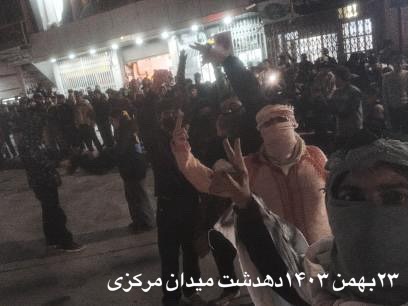Over the past week, for several consecutive nights, the city of Dehdasht in Kohgiluyeh and Boyer-Ahmad province has witnessed widespread protests against recurring power outages, economic hardships, and government repression. These protests were met with a harsh crackdown by security forces and police.
Regime-affiliated sources attempted to portray the protests as ethnic clashes between local groups. However, published images and videos show that protesters are not chanting ethnic slogans but are instead directing their anger at the regime and its leaders.
In recent months, Iran has been grappling with a severe economic crisis. International sanctions, corruption, and mismanagement have led to a decline in the value of the rial and soaring inflation. Energy shortages, caused by years of mismanagement and insufficient investment, have further exacerbated the crisis. These shortages have forced the closure of government offices, schools, universities, and have disrupted production in dozens of factories.


According to Iran’s Chamber of Commerce, industrial facilities operated at only 41% of their capacity last month due to power and natural gas shortages. This decline in production, particularly among poultry and meat suppliers, threatens the country’s food security. Additionally, according to the Iranian Labour News Agency (ILNA), energy shortages have led to the shutdown of 22 cement factories and a decline in pharmaceutical production. These issues have fueled public discontent and increased protests across various regions. Basic commodities such as rice, dairy products, and cooking oil have seen price hikes of up to 110% over the past year, worsening the financial strain on families.
During the Woman, Life, Freedom protests, Dehdasht was one of the major centers of unrest. On November 16, 2022, Islamic Republic security forces opened fire on protesters in the city, killing several people.
These events in Dehdasht, Kohgiluyeh and Boyer-Ahmad province, mark yet another episode in the continuing cycle of popular uprisings in Iran. A group of youth set fires in several neighborhoods and moved toward the city’s central square. Wall writings appeared in other Lur-populated cities such as Yasuj and Masjed Soleyman in solidarity. Several protesters detaineed and have been identified by activists so far. With the city now under heavy security-military control, the prospects for sustained street protests remain uncertain.
It is unclear whether, as in previous uprisings since December 2017, the initial sparks of unrest will be extinguished through repression or spread to other cities. The slogans heard—”Death to Khamenei,” “Death to the dictator,” and “From Dehdasht to Tehran, unity, unity”—suggest a broad discontent, yet different forces attempt to impose their narratives onto the protests. Some analysts have linked the protests to economic pressure, particularly the surging price of the dollar. Others attribute them to a purely ethnic reaction. Meanwhile, dominant right-wing media outlets seek to strip the protests of their class and peripheral nature, framing them instead as part of their broader anti-1979 reactionary rhetoric. However, what has largely been ignored is the prolonged continuity of what could be termed the “uprising of the hungry”—an intersection of class struggle and national oppression.
شب شنبه ۲۵ شهریور مردم شهر دهدشت تجمع کرده و شعارهایی علیه حکومت سر دادند و ماموران به سمت مردم تیراندازی کردند. معاون سیاسی و امنیتی استاندار کهگیلویه و بویراحمد شمار معترضان بازداشتشده دهدشت را ۱۵ تن (۱۳ مرد و ۲ زن) اعلام کرد و گفت برخی دیگر شناسایی شدهاند.#مهسا_امینی#دهدشت pic.twitter.com/LXO9OmhF2k
— Reza Akvanian (@akvanian) September 16, 2023
این ویدئو ۳۱ شهریور از لحظهی شلیک نیروهای امنیتی به قلب #مهرداد_بهنام_اصل در #دهدشت گرفته شده. ماموران امنیتی بیهدف به سمت مردم شلیک میکنند؛ اینجا مشخص است مهرداد گوشهای ایستاده که ماموران نشانه گرفته و گلولهای به قلبش میزنند و همانجا جان عزیزش را از دست داد.#مهسا_امینی pic.twitter.com/lQuD6ifKSG
— Reza Akvanian (@akvanian) October 4, 2022
This is not an isolated eruption. Lurs played a central role in the uprising of the hungry, as seen in their cities like Farsan, Izeh, Babaheydar, Andimeshk, and beyond. The fundamental contradiction in these movements is the attempt by the ruling class to erase the class character of the protests while instrumentalizing elements of national identity to fragment them. The capitalist system in Iran has historically depended on national oppression as a tool to maintain class divisions and facilitate capital accumulation. The systematic looting of resources, record-breaking unemployment rates, the environmental destruction caused by neoliberal policies, and systemic deprivation—all are rooted in class struggle.
Even within the official statistics of the regime, Charmahal and Bakhtiari province, a focal point of the uprising of the hungry, recorded the highest misery index in Iran in the fall of 2023—standing at 62.3%. The province’s unemployment rate, despite the state’s manipulated definitions, remains exceptionally high. The same pattern holds for Lur-populated provinces like Lorestan, Kohgiluyeh and Boyer-Ahmad, and Charmahal and Bakhtiari, which have topped the misery index multiple times over the past decade.
The protest in Dehdasht, taking place in a province rich in oil and gas reserves yet plagued by poverty, is another expression of this class struggle. While major cities in Iran remain paralyzed by political despair, it is the most marginalized—those caught at the intersection of class and national oppression—who take to the streets and write the word “beginning” on the walls. In Kohgiluyeh and Boyer-Ahmad, outside the relatively better-off cities of Yasuj and Gachsaran, the economic reality is dire.
The province provides 25% of Iran’s oil and gas resources, second only to Khuzestan, yet its people remain in deep poverty. Its cities, such as Dehdasht, serve as reservoirs of cheap labor for industrial centers like Asaluyeh, Chabahar, and Mahshahr. Unemployment rates remain significantly high, forcing mass migration to Tehran, Shiraz, and Yazd. This reality underscores the fundamentally class-based nature of these protests.
Historically, the structure of Dehdasht’s neighborhoods was shaped by tribal affiliations. However, the neoliberal restructuring of Iran’s economy has altered this dynamic. Migration—both from impoverished villages and among formerly semi-nomadic populations—has reshaped the city’s demographics. Decades of forced settlement policies targeting nomadic groups, coupled with economic disintegration, have transformed the nature of social stratification. Those who once migrated voluntarily with economic resources now differ from today’s displaced, who arrive with little but their labor power and anger.
جواب اعتراض مردم، گلوله نیست.
— Narges Mohammadi | نرگس محمدی (@nargesfnd) February 17, 2025
صدای مردم را با گلوله نمیتوانید، خاموش کنید.
مردمی که به موجب سیاستهای جمهوری اسلامی در وضعیت بد اقتصادی و معیشتی و گرانی و تورم و بیکاری درتقلایند، در صورت اعتراض هم به جای رسیدگی و پاسخگویی از سوی مسئولان با گلوله سرکوب می شوند.
بار دیگر… pic.twitter.com/LohZkPdwSH
گروهی از شهروندان معترض در جریان اعتراضات ضدحکومتی شامگاه ۲۳ بهمن در شهر #دهدشت در استان #کهگیلویه_و_بویراحمد به نشانه اعتراض آتش روشن کردهاند. این ویدیو نشان میدهد که ماموران با اسلحههای خود به سمت معترضان شلیک میکنند.pic.twitter.com/UwB7KZrVzX
— Reza Akvanian (@akvanian) February 16, 2025
Despite these profound structural changes, class struggle in Dehdasht has largely remained fragmented. The precarity of the workforce limits its ability to organize sustainable labor movements. Nonetheless, sectors such as healthcare workers, municipal employees, truck drivers, and teachers have staged repeated strikes and protests over the past decade. However, given the state’s ability to identify and suppress activists swiftly in smaller cities, these struggles remain isolated. The challenge, therefore, lies in overcoming these structural barriers through clandestine organization and political continuity beyond spontaneous uprisings.
The significance of the Dehdasht uprising is that, at a time when despair dominates Iran’s urban centers, and individual acts of nihilistic defiance are glorified, it is the most oppressed who return to the streets, forcing the question of class struggle back onto the historical stage. But when the streets of Dehdasht call for unity with Tehran, it is critical to ask: which Tehran? If that Tehran is the affluent neighborhoods cheering for the ghost of Reza Shah—the very figure whose hands were stained with the blood of the Lur people—then this unity is a mirage, a deception meant to neutralize revolutionary potential. The true unity must be with those in Tehran who share the conditions of exploitation, who also hear the echoes of hunger and unemployment in their daily lives. Anything less is a betrayal, a dilution of struggle into reactionary nostalgia.










